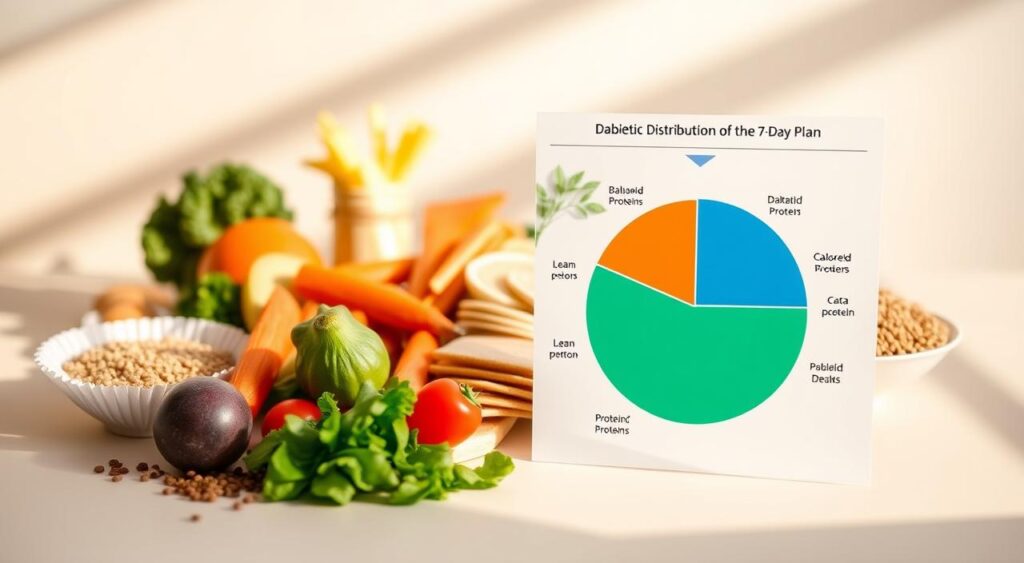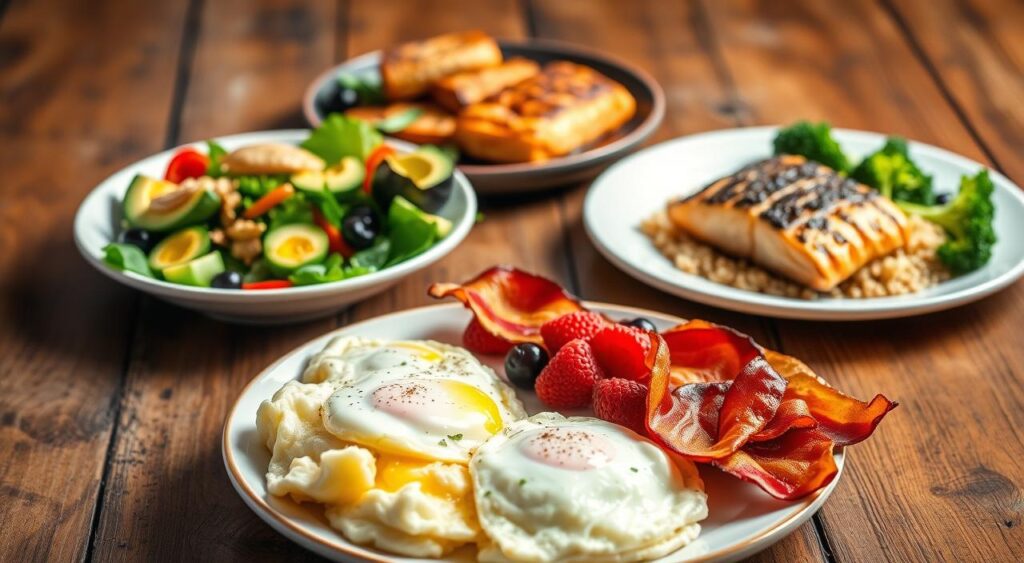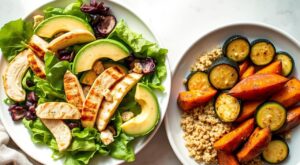Welcome to your journey towards better health with our 7-day diabetic meal plan for weight loss. This plan balances your blood sugar levels and helps you burn fat. Each meal is packed with protein and fiber, making you feel full without losing flavor.
This low carb diabetic meal plan is flexible, fitting your personal calorie needs. It’s designed to meet your dietary needs and preferences.
By following this plan, you can enjoy delicious meals that support your weight loss efforts and enhance your overall well-being. Let’s dive into the details and explore how this meal plan can work for you!
Understanding the Importance of a Diabetic Meal Plan
A good diabetic meal plan is key for keeping blood sugar levels in check and helping with weight loss. It lets you eat a variety of foods that keep your nutrient intake balanced. This lowers the chance of diabetes-related problems. By sticking to a diabetic meal prep for weight loss, you make it easier to choose healthier foods.
One big plus of a meal plan is controlling portions. The right portion sizes help avoid blood sugar highs and aid in weight control. With a diabetic meal plan delivery, you get meals tailored to your health needs. This takes the guesswork out of what to eat.
Using a meal plan opens you up to new recipes and ingredients. This makes eating healthier more fun and keeps you on track. It’s important to have the right mix of carbs, proteins, and fats for energy and health.
| Benefits of a Diabetic Meal Plan | Description |
|---|---|
| Blood Sugar Control | Helps manage and stabilize blood sugar levels through balanced nutrient intake. |
| Weight Loss | Aids in achieving weight loss goals by promoting portion control and healthy choices. |
| Variety | Encourages diverse food options, making healthy eating more enjoyable. |
| Convenience | Meal prep or delivery services save time and reduce stress associated with meal choices. |
In short, a dedicated diabetic meal plan is vital for your health. It helps improve your life by managing blood sugar and aiding in weight loss.
Benefits of Weight Loss for Diabetics
Weight loss is key for managing diabetes. Losing a small amount of weight can make your body more sensitive to insulin. This helps keep your blood sugar levels in check. A weight loss program made just for you can lead to better health.
Studies show losing 5-10% of your body weight can greatly improve your health. It can lower your risk of heart disease. This not only boosts your physical health but also makes life better overall. Using diabetic weight loss recipes can make meal planning easier and keep you on track.
Adding these recipes to your diet helps you eat healthier and lose weight for good. A well-planned program can help you reach your goals and keep them.
How This 7-Day Diabetic Meal Plan Was Created
Registered dietitians and nutrition experts created this meal plan. They focused on a balanced diet. They made sure the calories were right for losing weight.
There are options for different calorie needs: 1,500, 1,800, and 2,000 calories. This makes it easy to find a plan that suits you.
Every day, you’ll eat meals high in protein and fiber. This keeps you full and stops you from snacking too much. The ingredients chosen help control your blood sugar and aid in weight loss.
This meal plan offers a variety of foods. You can try new flavors and textures while staying on track with your diet. It’s a great way to take care of your body and reach your health goals.
Caloric Distribution of the 7-Day Plan
The 7-day diabetic meal plan is designed for about 1,500 calories a day. It’s flexible to fit your needs, even if you need more calories. Eating balanced meals is key to getting enough nutrients and keeping blood sugar in check.
Every day, the plan spreads out calories to keep you energized. Experts say to keep added sugars under 10% of your daily calories. Also, cut down on saturated fats for better health. Carbs should be 45% to 65% of your calories to boost energy and stabilize blood sugar.
This careful planning lets you enjoy your meals while following diabetes management tips. By sticking to the calorie-controlled diet, you’re on your way to better health and well-being.

Daily Nutritional Goals of the Meal Plan
Setting daily nutritional goals is key to success on a diabetic meal plan app. Aim for at least 85 grams of protein and 28 grams of fiber each day. This helps you feel full and keeps blood sugar stable.
Daily Protein Intake
Get protein from lean meats, fish, legumes, and dairy. Mixing up your protein sources makes meals nutritious and satisfying. It also helps maintain muscle and keeps you full, which is important for diabetes management.
Importance of Fiber
Fiber is also vital for digestion and keeping glucose levels steady. Include whole grains, fruits, and vegetables in your diet to hit your fiber goal. High-fiber foods boost the diabetic meal plan app’s effectiveness, helping you reach your health goals and enjoy balanced meals.
| Nutrient | Daily Goal | Sources |
|---|---|---|
| Protein | 85 grams | Lean meats, fish, legumes, dairy |
| Fiber | 28 grams | Whole grains, fruits, vegetables |
Outline of the 7-Day Diabetic Meal Plan for Weight Loss
Creating a balanced meal plan for weight loss with diabetes is key. This 7-day plan offers a variety of meals to keep you full and healthy. Each day includes breakfast, lunch, dinner, and snacks, ensuring you stay nourished.
Every meal combines healthy carbs, lean proteins, and non-starchy veggies. This mix helps manage blood sugar and aids in weight loss. Here’s a look at what you’ll eat each day:
| Day | Breakfast | Lunch | Dinner | Snacks |
|---|---|---|---|---|
| Day 1 | Oatmeal with berries | Grilled chicken salad | Baked salmon with broccoli | Carrot sticks |
| Day 2 | Greek yogurt with nuts | Tuna wrap with lettuce | Stir-fried tofu with vegetables | Apple slices |
| Day 3 | Smoothie with spinach | Quinoa salad with beans | Grilled shrimp with asparagus | Rice cakes |
| Day 4 | Scrambled eggs with tomatoes | Turkey sandwich on whole grain | Baked chicken with sweet potatoes | Cucumber slices |
| Day 5 | Pancakes made with almond flour | Vegetable soup | Grilled steak with green beans | Trail mix |
| Day 6 | Chia seed pudding | Chickpea salad | Fish tacos in lettuce wraps | Celery sticks |
| Day 7 | Whole grain toast with avocado | Stuffed bell peppers | Roasted vegetable medley | Hard-boiled eggs |
This meal plan ensures you get all the nutrients you need while keeping calories in check. Adjust portion sizes as needed, but the core structure supports a healthier lifestyle.
Meal Prep Tips for Success
Starting a diet for weight loss with meal prep can be a game-changer. It saves time and helps you make better food choices. Here are some tips to help you stay on track and enjoy your meals.
Batch Cooking Ideas
Batch cooking makes meal planning easier. Here are some ideas to get you started:
- Make big batches of vegetable soups and stews. They’re full of nutrients and easy to portion.
- Cook whole grains like quinoa or brown rice in bulk. They’re great bases for meals.
- Roast a variety of vegetables at once. Use them in salads, wraps, or as sides.
- Grill or bake protein-rich foods, like chicken or tofu. Season them differently for variety.
Storing Meals Safely
Storing meals right is key to keeping them fresh. Follow these tips for safe meal storage:
- Use airtight containers to keep meals fresh. It prevents spoilage and keeps flavors good.
- Label containers with dates to track freshness.
- Freeze portions that won’t be eaten in a few days. It extends their shelf life.
- Keep your fridge organized. It makes finding meals easy and prevents waste.
Using these meal prep strategies makes your weight loss journey more fun and lasting. With a bit of planning, you’ll always have healthy, tasty meals ready when you need them.
Sample Day 1: Breakfast, Lunch, and Dinner Menu
Begin your day with a nutritious breakfast. Try a delicious egg scramble. Mix eggs, spinach, and tomatoes for a protein-rich start. Add a fresh pear for extra fiber and sweetness.
This combo is perfect for a diabetic meal plan for weight loss. It keeps you full until lunchtime.
For lunch, enjoy a hearty chicken salad. Use grilled chicken, mixed greens, cucumbers, and cherry tomatoes with a light vinaigrette. This meal is full of nutrients and supports your weight loss.
Pair your lunch with a small cup of yogurt and fresh berries. It’s a healthy snack that’s both tasty and good for you.
Dinner is a vibrant salmon Caesar salad. Grilled salmon adds omega-3 fatty acids, supporting heart health and weight loss. The salad mix and light dressing make it refreshing and part of your diabetic meal plan.

Sample Day 2: Breakfast, Lunch, and Dinner Menu
Day 2 of your healthy diabetic meal plan is full of tasty meals. Start with a yogurt parfait. It has Greek yogurt, fresh berries, and nuts. This breakfast is packed with protein and healthy fats, keeping your blood sugar stable.
For lunch, try stuffed peppers with quinoa, black beans, and tomatoes. The veggies and beans add fiber, making you feel full. They also make your meals more exciting and satisfying.
Dinner brings a cabbage roll skillet. It has ground turkey, brown rice, and cabbage leaves in a tomato sauce. This meal offers lean protein and complex carbs, key for a balanced diet with diabetes. Each meal is designed to give you the right nutrition without harming your health.
Day 2 shows that a healthy diabetic meal plan can be both easy and tasty. This variety keeps you motivated and committed to your health goals.
Healthy Snack Options to Include
Healthy snacks are key for managing weight and blood sugar. They keep you full and energized between meals. Try adding diabetic weight loss recipes to your snacks to stay on track with calories.
Here are some tasty and healthy snack ideas:
- Apple slices paired with almond butter.
- Carrot sticks served with hummus.
- Greek yogurt topped with berries.
- Cucumber slices with feta cheese.
- A small handful of mixed nuts.
These snacks are not only delicious but also good for your health. Adding diabetic weight loss recipes to your snacks helps keep your diet balanced and tasty.
| Snack Option | Calories | Protein (g) | Carbs (g) | Fiber (g) |
|---|---|---|---|---|
| Apple with Almond Butter | 180 | 4 | 25 | 5 |
| Carrots with Hummus | 150 | 3 | 22 | 6 |
| Greek Yogurt with Berries | 120 | 10 | 18 | 4 |
| Cucumber with Feta Cheese | 90 | 5 | 8 | 2 |
| Mixed Nuts | 200 | 6 | 8 | 3 |
Adding these healthy snacks to your daily meals helps control hunger and enjoy tasty food. These diabetic weight loss recipes are great for losing weight and improving your diet.

Glycemic Index and Its Role in Meal Planning
The glycemic index (GI) is key in making a healthy meal plan for diabetics. It ranks carbs by how much they raise blood sugar. Foods with a low GI, like whole grains and fruits, keep blood sugar steady.
Knowing the GI helps you plan meals better. Mixing low GI foods with higher GI ones makes meals satisfying and safe for blood sugar. Choose foods based on their GI to meet your health needs.
Eating a mix of low to moderate GI foods makes your meal plan better. This approach helps keep blood sugar stable and promotes healthy eating.
Adapting the Meal Plan Based on Caloric Needs
Adjusting your meal plan for weight loss is key to reaching your health goals. If you’re active, you might need more calories. This could mean eating bigger portions or adding healthy snacks.
For Active Individuals
If you’re always on the move, here’s how to adjust your meal plan:
- Eat more complex carbs like whole grains to fuel your workouts.
- Add lean proteins like chicken or fish to help your muscles recover.
- Include healthy fats from avocados and nuts to keep your energy up.
For Weight Maintenance
If you want to keep your weight the same, focus on balancing calories. Here are some tips:
- Watch your portion sizes to avoid eating too much.
- Eat a variety of colorful fruits and veggies to get all the nutrients you need.
- Choose whole foods over processed ones to keep your blood sugar stable.

Tips for Eating Out While Following the Plan
Eating out while following a diabetic meal plan for weight loss is doable with smart strategies. Start by looking at menus before you go. This helps you find dishes that fit your diet.
Look for grilled or baked proteins instead of fried foods. Grilled chicken, fish, or vegetable platters are good choices. They help keep your blood sugar stable.
Controlling your portion size is key. Try splitting your meal or taking half home. This prevents eating too much. Choose meals with protein, healthy fats, and complex carbs for a balanced meal.
For example, a salad with lean protein and a vinaigrette dressing is both tasty and healthy.
Also, ask for dressing and sauces on the side. This lets you control how much you use. Desserts can be tempting, but choose fruit or share a dessert to enjoy without overdoing it.
By planning your meals carefully when eating out, you can stay on track with your health goals. Use these tips to enjoy dining out while supporting your weight loss journey.
Common Challenges and Remedies
Starting a diabetic weight loss program can be tough. You might find yourself craving unhealthy foods. Social events can also make it hard to follow your meal plan. And, finding time to cook healthy meals can be a challenge.
But, there are ways to overcome these obstacles:
- Meal Prepping: Cook your meals for the week ahead. This stops you from making unhealthy choices when you’re hungry.
- Keep Healthy Snacks Accessible: Have healthy snacks ready in your kitchen. Options like fruits, nuts, or low-carb snacks are great for quick energy boosts.
- Seek Support: Join a group or community focused on diabetic weight loss. Sharing your journey with others keeps you motivated and accountable.
Monitoring Your Progress on the Plan
Tracking your progress is key when you’re on a diabetic meal plan. It’s important to check your weight, blood sugar levels, and overall health often. A diabetic meal plan app can make this easier. These apps let you log your meals, track portion sizes, and record your blood sugar.
Apps for diabetic meal plans offer insights into your eating habits. They show trends with charts and graphs. This helps you see which foods affect your blood sugar. Plus, they keep you accountable and motivated to reach your health goals.
Set clear goals to track your progress. For instance, aim for stable blood sugar levels or a slow weight loss of one to two pounds a week. Here’s a simple table to track your progress:
| Date | Weight (lbs) | Blood Sugar Level (mg/dL) | Notes |
|---|---|---|---|
| Week 1 | 180 | 120 | Started meal plan |
| Week 2 | 178 | 115 | Felt great, energy levels up |
| Week 3 | 177 | 110 | Eating out less |
| Week 4 | 175 | 108 | Definite improvement |
With regular tracking using a diabetic meal plan app, you can tweak your plan as needed. Approach this journey with excitement. Every step you take is a step towards better health and wellbeing.
Staying Motivated on Your Journey
Starting a journey with a diabetic meal plan for weight loss is both thrilling and tough. Staying motivated is key to keeping up with this lifestyle change. Setting achievable goals helps you make steady progress without feeling too much pressure.
Having friends and family support you can really help. Being around positive people keeps you on track. When you share your goals and successes, you get more encouragement. This makes it easier to keep going with your diabetic meal plan.
It’s important to celebrate the little wins. Maybe you’ve followed your meal plan for a week or seen health improvements. Recognizing these moments boosts your confidence and helps you keep up good habits. Always keep your long-term health goals in mind. This helps you stay committed to your journey.
Conclusion
The 7-day diabetic meal plan for weight loss is a key tool for managing diabetes and losing weight. It offers a structured meal plan and stresses the need for balanced nutrients. By considering your calorie needs, you can enjoy food healthily.
This plan helps you with meal prep and mindful eating. It makes cooking easier, helping you stay on track. As you make changes, you’ll see lasting health benefits.
This plan lets you control your diet. By sticking to these meals and habits, you’ll improve your health and well-being. It’s a chance to nourish your body and manage your diabetes effectively.














